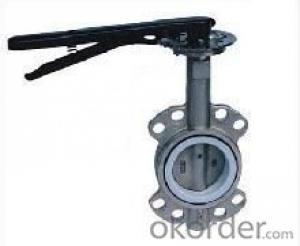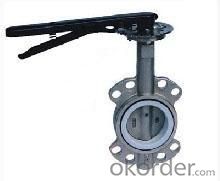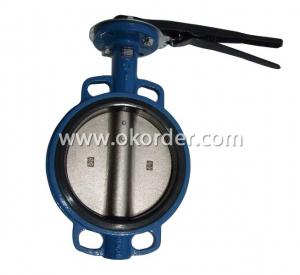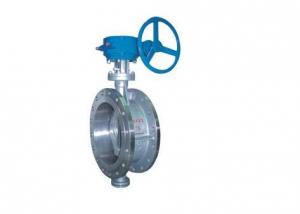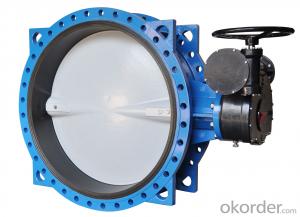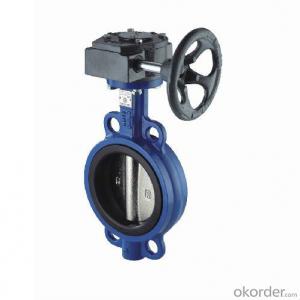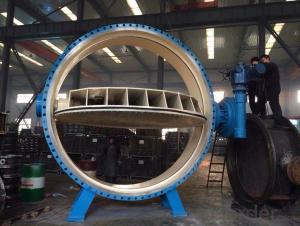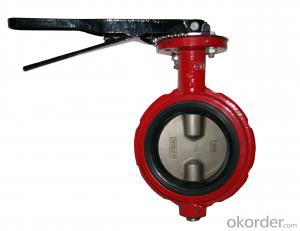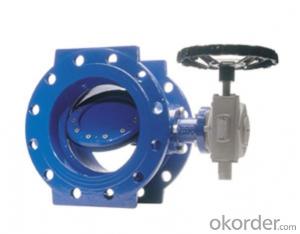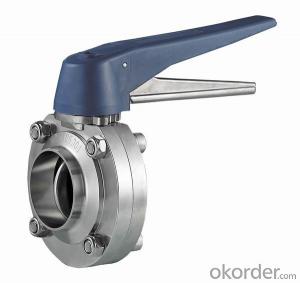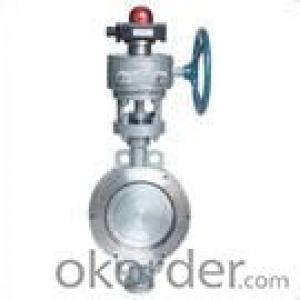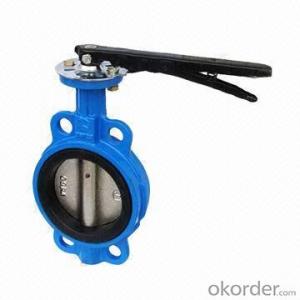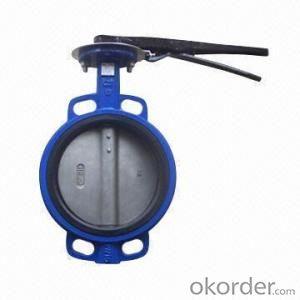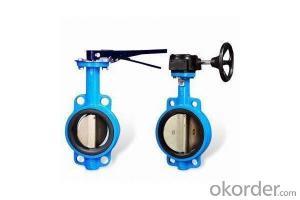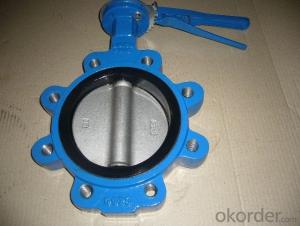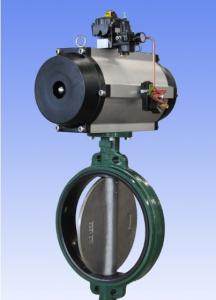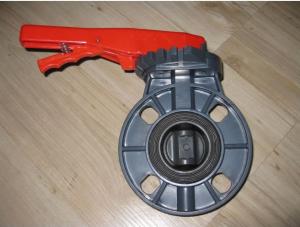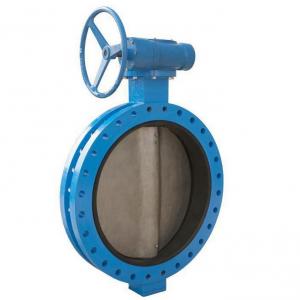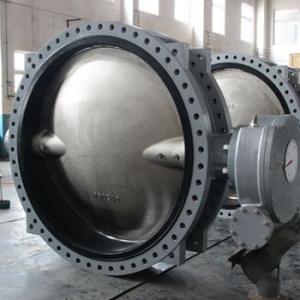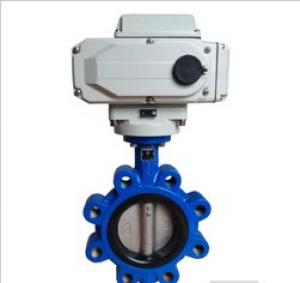butterfly valve DN40mm-DN300
- Loading Port:
- China Main Port
- Payment Terms:
- TT OR LC
- Min Order Qty:
- -
- Supply Capability:
- -
OKorder Service Pledge
OKorder Financial Service
You Might Also Like
Quick DetailsStandard or Nonstandard: Standard Structure: Gate Pressure: Medium Pressure
Power: Manual Material: Casting Temperature of Media: Medium Temperature
Media: Water Port Size: DN40mm-DN300 Place of Origin: China (Mainland)
Model Number: GF4 resilient gate valves: resilient seat flange
Packaging & DeliveryPackaging Detail: air plastic bag inside/wooden box outside
Delivery Detail: 15-60days
SpecificationsDIN3352 F4 resilient seat flange gate valves
1.s:DN40-DN300 ize
2.medium:water
3.standard:DIN
4.certificate:ISO9001 CE
resilient gate valves
1.size:DN40-DN300
2.medium:water
3.certificate:ISO9001 CE
4.standard:DIN
available medium:water
working temperature:≤80oC
flange dimensions:DIN2501
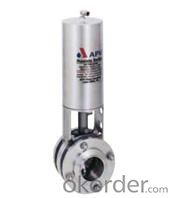
- Q: I am confused as to the answer of this question. Please help.Indicate the status of the mitral, tricuspid and semilunar valves (whether they are open or closd) during the various phases of the cardiac cycle. Discuss the pressure in each of the relevant chambers or blood vessels during the phases with reference to the opening or closing of the valves.
- A heartbeat is a two-part pumping action that takes about a second. As blood collects in the upper chambers (the right and left atria), the heart's natural pacemaker (the SA node) sends out an electrical signal that causes the atria to contract. This contraction pushes blood through the tricuspid and mitral valves into the resting lower chambers (the right and left ventricles). This part of the two-part pumping phase (the longer of the two) is called diastole. The second part of the pumping phase begins when the ventricles are full of blood. The electrical signals from the SA node travel along a pathway of cells to the ventricles, causing them to contract. This is called systole. As the tricuspid and mitral valves shut tight to prevent a back flow of blood, the pulmonary and aortic valves are pushed open. While blood is pushed from the right ventricle into the lungs to pick up oxygen, oxygen-rich blood flows from the left ventricle to the heart and other parts of the body. After blood moves into the pulmonary artery and the aorta, the ventricles relax, and the pulmonary and aortic valves close. The lower pressure in the ventricles causes the tricuspid and mitral valves to open, and the cycle begins again. This series of contractions is repeated over and over again, increasing during times of exertion and decreasing while you are at rest. The heart normally beats about 60 to 80 times a minute when you are at rest, but this can vary. As you get older, your resting heart rate rises. Also, it is usually lower in people who are physically fit.
- Q: Ok, so I took my car in for maintenance (Mustang GT convertible 2002) and the mechanic told me the valve gaskets needed to be replaced and when he gave me the estimate, they were two seperate charges for valve gaskets and valve covers, total of about $250.00 not including labor. Is he trying to rip me off cause I'm a girl by the way? Anyways, I didn't get it done cause it needed something else too and I didn't have enough money so I said I would be back in two weeks. So I called the dealership to inquire about the price and I asked the parts guy for a price on valve gaskets and he was like, I don't know what you mean, we have valve cover gaskets but nothing says just valve gaskets? I told him to give me the price anyways, thinking I would ask my brother (who hasn't tried to help me anyways) and it was $60.00 for both (I need two). How can this be if the other guy was charging me $250.00 for different parts? Help!!! Frustrated and confused, I don't know anything about cars :(
- here okorder /... usually you can tell when a car needs the gasket to be replaced because it will leak oil where the gasket is at the bottom of the cover i think hes ripping you off because cars usually dont need to have the valve cover replaced, just the gaskets so take it to another mechanic and get another estimate
- Q: For whatever reason, Mazda has made it next to impossible to change the PCV valve on the 929. I'm going to have to pull off the plenum and the passenger's side valve cover to replace a $2.00 PCV valve. Before I get too involved, I need to know the torque specs for the valve cover. Also, any other tips on this process would be greatly appreciated. Can I reuse the old valve cover gasket if it's still in good shape? Should I use any kind of sealant in addition to the gasket when I put it all back together? Thanks in advance, by looking at this motor, I can tell I'll have my work cut out for me (for a friggin $2.00 PCV valve, it's usually SO simple!). Like I said, any and all help is greatly appreciated.
- Mazda 929 Specs
- Q: What does the butterfly valve model d344h, d345h, d346h, d347h mean?
- According to the international standard of the letters and numbers apart to explain D344H D is a unit of butterfly valve, two unit 3 is driving mode: turbine, three unit 4 connection: flange connection, four unit 4 Structure: seal type linkage, five unit H sealing material: Cr13 stainless steelD345H compare yourself to the above. Unit 5 four is a sealed, single eccentric structureD346H four unit 6 is an unsealed center vertical plateD347H four unit 7 is unsealed double eccentricIn general, there is only one difference between them: the structural form is different!
- Q: What are single eccentric and double eccentric in butterfly valves? What's the difference, please explain in detail?
- Eccentric butterfly valve is divided into single eccentric butterfly valve, double eccentric butterfly valve, three eccentric butterfly valve, variable eccentric butterfly valve.Single eccentric butterfly valve: extrusion problems, address concentric butterfly valve and valve seat of the resulting in a single eccentric butterfly valve, the structural characteristics of the stem axis deviated from the disc center, so that the butterfly is no longer a rotary bottom plate, axial dispersion, reduce the excessive squeezing and the lower end of the seat of the butterfly board.
- Q: Specifically an engine valve retainer.
- TRhe retainer and locks works together to hold valve to spring and keep valve from falling into the cylinder and spring from coming off the top. The locks are tappered, small end at bottom, big end at top. You compress the spring down, drop retainer over valve, put locks in groove of valve stem and pull up on the retainer to lock the retainer and locks in place, the relese the pressure off your spring compressor and the valve spring now holds pressure up on retainer which forces up on the big end of locks and holds everything together
- Q: DN80 flange butterfly valve, DN80 flange butterfly valve DN80, flange butterfly valve DN80 what is the difference?
- Of course there are differences, the general market sales of the DN80 are many flange plate copper rod butterfly valve, quality can not reach the national standard, to use copper rod copper butterfly valve quality is king.
- Q: The difference between vertical and horizontal butterfly valves in municipal water supply
- Function is no difference, mainly the installation conditions are not the same, vertical valve shaft in the vertical direction, the valve well on the deep, horizontal valve shaft in the horizontal direction, the valve width to be larger, and the other is no difference
- Q: Which is more expensive, gate valve or butterfly valve?
- Gate valves of the same material and specifications are much more expensive. The weight of the gate valve is much heavier than that of the butterfly valve.
- Q: D341W-10P-400 butterfly valve, what does each alphanumeric letter mean?
- According to JB/T308-2004 "valve type programming method"D butterfly valve3 worm gear4 flange connection1 Structure: sealed type, central vertical plateW sealing material for valve body material10 nominal pressure PN10P body material is chromium nickel stainless steel400 shall be nominal size DN400
Send your message to us
butterfly valve DN40mm-DN300
- Loading Port:
- China Main Port
- Payment Terms:
- TT OR LC
- Min Order Qty:
- -
- Supply Capability:
- -
OKorder Service Pledge
OKorder Financial Service
Similar products
Hot products
Hot Searches
Related keywords
